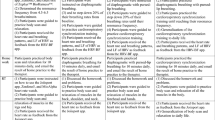Abstract
McKinney et al. (1980) reported large-magnitude reductions in heart rate (HR) from resting baseline levels, employing shaping and fading techniques and a reinforcement program in which a secondary reinforcer was awarded both contingently and immediately during training. The four male subjects in this group showed significantly greater HR decreases than a group of four males receiving beat-by-beat analogue HR feedback. The present study compared decreases in HR in 20 male subjects receiving the contingently faded biofeedback procedure to those shown by 10 male subjects for whom reinforcement was contingent on vigilant observation of a visual display, and independent of HR. The former group showed significantly greater decreases in HR that could not be attributed to elevated baseline levels. However, the decreases in HR were not as large as those reported by McKinney et al. (1980). It is argued that future research should assess variables contributing to individual differences in performance.
Similar content being viewed by others
References
Black, A. H., Cott, A., & Pavloski, R. (1977). The operant learning theory approach to biofeedback training. In G. Schwartz & J. Beatty (Eds.),Biofeedback: Theory and research (pp. 89–127). New York: Academic Press.
Blanchard, E. B., & Young, L. D. (1973). Self-control of cardiac functioning: A promise as yet unfulfilled.Psychological Bulletin, 79 145–163.
Downing, S. E. (1979). Baroreceptor regulation of the heart. In R. M. Berne, N. Sperelakis, & S. R. Geiger (Eds.),Handbook of physiology. The cardiovascular system (Vol. 1, pp. 621–652). Washington, D.C.: American Physiological Society.
Engel, B. T., & Joseph, J. A. (1982). Attenuation of baroreflexes during operant cardiac conditioning.Psychophysiology, 19 609–614.
Hatch, J. P., & Gatchel, R. J. (1981). The role of biofeedback in the operant modification of human heart rate.Biofeedback and Self-Regulation, 6 139–167.
McKinney, M. E., Geller, D., Gatchel, R. J., Barber, G., Bothner, J., & Phelps, M. E. (1980). The production and generalization of large-magnitude heart rate decleration by contingently faded biofeedback.Biofeedback and Self-Regulation, 5 407–416.
Miller, N. E., & Dworkin, B. (1974). Visceral learning: Recent difficulties with curarized rats and significant problems for human research. In P. A. Obrist, A. H. Black, J. Brener, & L. V. DiCara (Eds.),Cardiovascular psychophysiology (pp. 312–331). Chicago: Aldine.
Smith, O. A., Astley, C. A., Hohimer, A. R., & Stephenson, R. B. (1980). Behavioral and cerebral control of cardiovascular function. In M. J. Hughes & C. D. Barnes (Eds.),Neural control of circulation (pp. 1–21). New York: Academic Press.
Smyth, H. S., Slight, P., & Pickering, G. W. (1969). Reflex regulation of arterial pressure during sleep in man: A quantitative method of assessing baroreflex sensitivity.Circulation Research, 24 109–121.
Stephens, J. H., Harris, A. H., Brady, J. V., & Schaffer, J. W. (1975). Psychological and physiological variables associated with large magnitude voluntary heart rate changes.Psychophysiology, 12 381–387.
Author information
Authors and Affiliations
Additional information
This research was supported by Ontario Heart Foundation Research Grant 15–37 to R. Pavloski.
Rights and permissions
About this article
Cite this article
Pavloski, R., Marlin, R. Contingently faded heart rate biofeedback: Attempted replication of large-magnitude decreases. Biofeedback and Self-Regulation 10, 189–196 (1985). https://doi.org/10.1007/BF01000754
Received:
Issue Date:
DOI: https://doi.org/10.1007/BF01000754




